The Nobel for Svante Pääbo is an attempt to redefine modern man
Understanding the value of our existence and reaching the roots of our evolution has been an intriguing subject for human beings. We cannot have a deep knowledge about our existence and evolution without going back to prehistory.
We have now been able to reach the roots of our origins by ‘digging’ into millions of years of history. Swedish scientist Svante Pääbo has won this year’s Nobel Prize in Physiology or Medicine for research on human evolution.
Pääbo, a 67-year-old geneticist at the Max Planck Institute for Evolutionary Anthropology in Leipzig, Germany, has revealed the secrets of Neanderthal DNA, helping us understand what makes humans unique.
Knowledge of Neanderthal DNA provides important insights into our immune system, including the weakening of our immunity to diseases such as COVID-19.
This research has put in place an entirely new scientific discipline, that of paleogenomics. With the genomes of many Neanderthals and Denisovans available, it is now possible to identify specific human genes.
The techniques developed under Pääbo’s leadership provided researchers the basis for comparing the genomes of Neanderthals with those of modern humans and other hominins such as Denisovans.
The Neanderthal, Homo neanderthalensis or Homo sapiens neanderthalensis, is an extinct species or subspecies of archaic humans that lived in Eurasia until about 40,000 years ago.
The cause of Neanderthals’ disappearance is highly debated, with a wide range of changes in climate to unknown diseases being blamed for their extinction.
It is not clear when Neanderthals’ battle for survival diverged from that of modern humans. Several studies have estimated various intervals from 315,000 to 800,000 years ago.
The date of divergence of Neanderthals from their ancestor Homo heidelbergensis is also not clear. The oldest possible Neanderthal bones date back to 430,000 years ago, but the classification remains uncertain.
Neanderthals are known from many fossils. The species was first located in 1856 in the Neander Valley of present-day Germany, identified from fossils that were 130,000 years old.
In the early 20th century, European researchers portrayed Neanderthals as primitive, foolish and cruel. Knowledge and perceptions about them have changed markedly in the scientific community since then.
We can fully understand relationships between species only by analysing DNA. But the challenge was that Neanderthals and modern humans diverged as a single species about 315,000 to 800,000 years ago.
How can the relationship (or inter-relationship) of the two species be pieced together across so many years? But Pääbo and his team overcame this challenge with their techniques.
Pääbo had to develop methods to analyse DNA that had been damaged by thousands of years of exposure to many elements in nature and had been contaminated with sequences from microorganisms and modern humans.
He and his colleagues then put these techniques to work in the sequence of the Neanderthal genome. This genetic analysis revealed that Neanderthals and Homo sapiens interbred and that Neanderthals form 1-4 per cent of the genomes of European or modern humans.
“Pääbo and his team also surprisingly found that there was gene flow from Neanderthals to Homo sapiens, indicating that they had children together during the period of co-existence,” Anna Wedell, chair of the Nobel Committee, said.
This transfer of genes between hominin species affects the response of modern humans’ immune system to infections such as the novel coronavirus. People outside Africa have 1-2 per cent of Neanderthal genes. Neanderthals were never in Africa. So no direct contribution from them is known among people in sub-Saharan Africa.
Wedell called this “a sensational discovery”, showing that Neanderthals and Denisovans were related groups that diverged from each other millions of years ago. Denisovan genes have been found in up to six per cent of modern humans in Asia and Southeast Asia, indicating that interbreeding took place there as well.
Wedell said, “After moving out of Africa and mixing with Denisovans, Homo sapiens picked up sequences that improved their chances of survival in the new environment.” For example, Tibetans share a gene with Denisovans that has helped them adapt to life at higher altitudes.
David Reich, a population geneticist at Harvard, who has worked closely with Pääbo on the Neanderthal genome sequence, said Pääbo’s Nobel win was a remarkable recognition of the maturing of this field.
He also wondered what would have happened if Neanderthals lived for 40,000 more years. Then perhaps today’s world would have been completely (or much) different. There probably would have been differences in the intellectual level and behaviour of people.
Wedell highlighted some of the social aspects emanating from the Nobel laureate’s research: “Will we see even worse racism against Neanderthals, because they were different from us in some ways? Or do we see ourselves in the living world? We will see the place in a different way when we have other forms of human beings who are like us but still different.”
The central theme of the 2022 Nobel Prize is an attempt to redefine modern man. DNA can be a bridge to true social relationships. If we have an awareness of the common sources of our origin, then a sense of unity will arise among societies.
Vir Singh is Emeritus Professor, GB Pant University of Agriculture and Technology
Views expressed are the author’s own and don’t necessarily reflect those of Down To Earth


